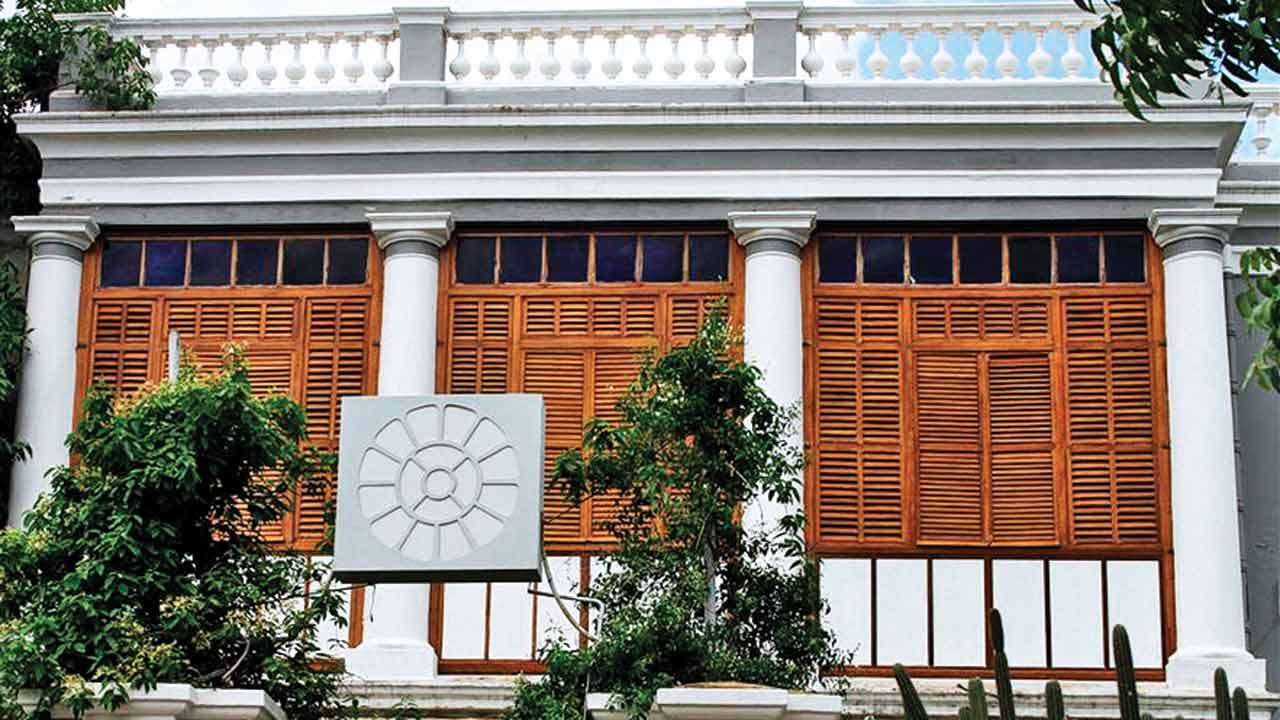
Tomorrow, Sunday, February 25, Prime Minister Narendra Modi is expected to make his first visit to Puducherry since assuming office in 2014. Arriving by a special flight, he is likely to be received by Chief Minister V Narayanasamy and his ministerial colleagues, before proceeding to the Sri Aurobindo Ashram and then to Auroville. At the Ashram, he will not only meditate at the Samadhi of Sri Aurobindo and the Mother, but also visit Sri Aurobindo’s room. Afterwards, he is invited to the Ashram School, Sri Aurobindo International Centre of Education, for an interaction with its gifted and privileged students. He is then scheduled to go to Auroville, the City of Dawn, founded by the Mother in 1968, to address an audience at Bharat Nivas. Auroville is celebrating its Golden Jubilee; what better culmination than the Prime Minister’s visit?
Modi is by no means the first Prime Minister of India to visit the Aurobindo Ashram. A remarkable photo dated October 4, 1955, shows three Prime Ministers with the Mother. Jawaharlal Nehru, the then incumbent, his successor Lal Bahadur Shastri, and daughter, Indira Gandhi, who later also became Prime Minister, along with the then Chief Minister of Madras, Kumaraswami Kamaraj, are in the picture. Indira Gandhi visited the Ashram again on October 6, 1969, with Nandini Satpathy, former Chief Minister of Orissa, whose son, Tathagata, studied in the Ashram school. Modi’s predecessor, Manmohan Singh, also stopped by the Ashram and Auroville on June 30, 2012. Earlier, PV Narasimha visited on August 23, 1986, when he was HRD minister, not the PM.
Why, then, is Modi’s visit of special significance? A clue is afforded in a message that the Mother gave to Indira Gandhi which, with the latter’s permission, was published in Sri Aurobindo Action: “The Supreme wants a great and free India.” Shyam Sunder Jhunjhunwala, a senior Ashramite, records Ms Gandhi’s explanation of the Mother words: “The Indian people should be more alive to their rich philosophical and cultural heritage and try to observe these high ideals in their daily life. This would strengthen us individually and help us to build a strong nation which would continue our long and ancient tradition of tolerance.”
Indeed, the root of such ideas of a resurgent India may be found in the writings of Sri Aurobindo. He, in turn, was inspired by masters such as Swami Vivekananda and Bankim Chandra Chatterjee. Aurobindo was undoubtedly The Prophet of Indian Nationalism, as indicated in the title of Dr Karan Singh’s book (1963). From Bhavani Mandir (1905), an unsigned, revolutionary pamphlet, inspired by a vision of Swami Vivekananda’s guru, Sri Ramakrishna, to his speech on the eve of Independence broadcast by AIR Trichy on August 14, 1947, the material, cultural, and spiritual renaissance of India was one of the key themes of Sri Aurobindo’s life and writings.
Indeed, in this independence-eve address to the nation, the first and fourth of Aurobindo’s five dreams of worldwide transformation were India-centric: “The first of these dreams … would create a free and united India. India today is free but she has not achieved unity. … But by whatever means, in whatever way, the division must go; unity must and will be achieved, for it is necessary for the greatness of India’s future.” The fourth dream, again, outlines India’s special role for the betterment of the world. “Another dream, the spiritual gift of India to the world has already begun. … That movement will grow; amid the disasters of the time more and more eyes are turning towards her with hope and there is even an increasing resort not only to her teachings, but to her psychic and spiritual practice.”
NaMo’s visit to Puducherry is important precisely because he is the best vehicle and agent we’ve had so far for the realisation of these dreams. What Indira Gandhi understood but dimly and failed subsequently from effecting, Modi may well recognise and accomplish. At least that is our hope. For Modi, more than any leader in India’s recent past, has re-articulated and re-embodied the dream of India’s renascent rise.
In this regard, Aurobindo’s inspiring words to the students of the newly established National College, the precursor of Jadavpur University, Calcutta, on August 23, 1907, acquire an added relevance and urgency: “Such a time has now arrived for our motherland when nothing is dearer than her service, when everything else is to be directed to that end. … All is contained in that one single advice.” NaMo’s visit to Puducherry may provide the inspiration if not benediction for the great work ahead which our Prime Minister is leading and expected to take to a decisive juncture.
The author is a poet and professor at JNU. Views expressed are personal.